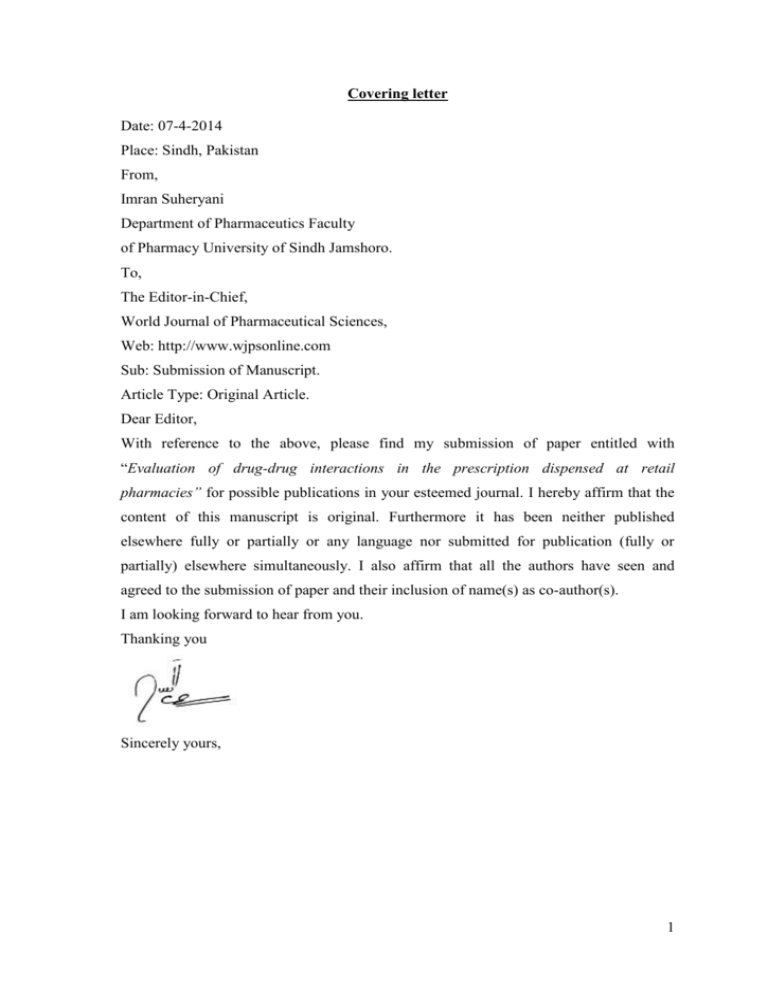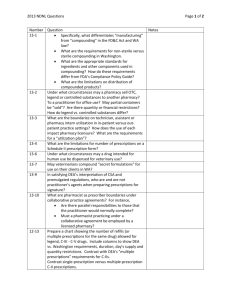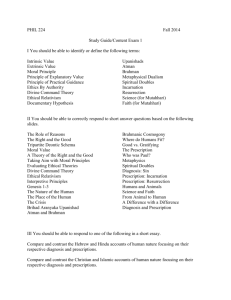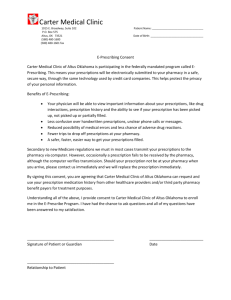department of pharmaceutics - World Journal of Pharmaceutical
advertisement

Covering letter Date: 07-4-2014 Place: Sindh, Pakistan From, Imran Suheryani Department of Pharmaceutics Faculty of Pharmacy University of Sindh Jamshoro. To, The Editor-in-Chief, World Journal of Pharmaceutical Sciences, Web: http://www.wjpsonline.com Sub: Submission of Manuscript. Article Type: Original Article. Dear Editor, With reference to the above, please find my submission of paper entitled with “Evaluation of drug-drug interactions in the prescription dispensed at retail pharmacies” for possible publications in your esteemed journal. I hereby affirm that the content of this manuscript is original. Furthermore it has been neither published elsewhere fully or partially or any language nor submitted for publication (fully or partially) elsewhere simultaneously. I also affirm that all the authors have seen and agreed to the submission of paper and their inclusion of name(s) as co-author(s). I am looking forward to hear from you. Thanking you Sincerely yours, 1 EVALUATION OF DRUG-DRUG INTERACTIONS IN THE PRESCRIPTION DISPENSED AT RETAIL PHARMACIES Imran Suheryani1*, Muhammad Ali Ghoto1, Abdullah Dayo1, Hina Saleem2, Muhammad Younis Laghari3, Marvi Baloch1, 1. Department of Pharmaceutics Faculty of Pharmacy University of Sindh Jamshoro. 2. Dow College of Pharmacy, Dow University of Health Sciences, Karachi. 3. Department of Fresh water biology and Fisheries University of Sindh Jamshoro. Phone number: 00923332830563 e-mail address: suheryaniimran@yahoo.com 2 ABSTRACT Drug Interactions is main issue of Health care system. This study was conducted to identify the nature and rate of occurrence of drug-drug interaction in prescriptions dispensed at retail pharmacies in Hyderabad, Pakistan. In this study the total 723 handwritten prescriptions were collected and from that only 630 clearly written prescription containing two or more than two medications were selected for analysis. Drug-drug interactions (DDIs) were detected by using the specially designed drug interaction checkers and detected interactions further confirmed by the Thomson Micromedex Health Care Series 2, British national formulary 63, Stockleys Drug Interaction checker. Out of total 630 prescriptions, 164 prescriptions (i-e 26%) of all the prescriptions contained 233 drug-drug interactions. Interactions then categorized on the basis of severity. On the basis of severity from the total 233 interaction, 26 (11%) of total interactions were of major type, 134 (58%) of total interactions were of moderate type and remaining 73 (31%) interactions were of minor type. Our study resulted that the prescriptions dispensed at retail pharmacies contained a high rate of drug-drug interactions. So an appropriate surveillance system must be implemented, physician and pharmacist must remain vigilant in investigation of drugdrug interactions to prevent adverse drug reaction. KEY WORDS: Drug Interactions, Prescription, Retail Pharmacy, Adverse drug Reaction, Synergism, Antagonism, Idiosyncratism 3 INTRODUCTION Drug to drug interaction (DDIs) are defined as “The change in the effects of one or more concurrently administered medicines [1,2] or “effects of one drug are changed by another drug is called as drug-drug interactions”. Or “simply we can say drug interactions occur when drugs fight with each other and deviate from the targeted aims.” Concomitant use of many drugs for a patient is necessary for achieving a set goal or in cases when the patient is suffering from more than one disease in these cases the chances of drug-drug interaction could increase [3]. The result of such drug-drug interaction could appear as synergism, antagonism, or idiosyncratism [4] and could cause an increase in the effects of drugs to the level of toxicity and can lead to harmful results or they can inhibit the effects of the drug and there will be loss of therapeutic benefit [5]. Therefore the pharmacist play an significant role in protecting the patients from drugdrug interactions, particularly in case of drugs with small margin of activity or narrow therapeutic window [6]. Drug –drug interaction is the main issue in drug therapy. It may results in either increased or decreased efficacy, in treatment failure or in an increased toxicity of medication [7]. A physician may inadvertently prescribe improper combination those results in less effects and more adverse drug reactions [8]. Patients visiting several physicians (who are prescribing less appropriate combinations) of the drugs due to unawareness of each other, the outcome of the therapy may be negatively influenced [9] and Concurrent use of prescriptions and non-prescription drugs. In addition the presence of certain diseases such as kidney failure or the use of more drugs at a time may increase the probability of drug interactions [10]. Mechanisms of Drug interactions Mechanisms of drug interactions may be quit varied and complex .In some cases more than one mechanism may be involved. It is most essential to understand the mechanism by which drug interaction occurs, and will be valuable to overcome the situation and to deal with the problems. Generally for convenience the mechanism of drug interactions can be subdivided into two classes a) Pharmacokinetic drug interactions: (The delivery of drug to its site of action is altered by second drug). Those interactions in which one drug (precipitant drug) changes the absorption, distribution, metabolism, or excretion of second drug (the object drug) with resultant change in the plasma concentration of second drug. 4 Simply pharmacokinetics drug interactions are those which will affect the processes by which drugs are absorbed, metabolized, distributed, and excreted. Due to changes in above mentioned pharmacokinetic processes there will be fluctuations in plasma drug concentration and also alteration in delivery of drug to site of action b) Pharmacodynamic drug interactions : ( The response of the drug target is modified by a second drug). In Pharmacodynamic drug interaction the actions of one drug are altered by the presence of another drug at receptor site or site of action. Sometimes the drugs will directly come in competition for specific receptors (eg. beta-blockers such as propranolol and beta-2 agonists like salbutamol). These interactions are much less easy to classify clearly as compare to pharmacokinetic drug interactions. Pharmacodynamic drug interaction involve additive (1+1= 2), potentiating (0+2=2), synergistic (1+1 =3) and antagonistic (1+1=0) affects at the level of receptors. MATERIAL AND METHOD Collection of Data This is a first study of its type in Hyderabad district of Pakistan. In this study data was collected through primary source from different retail pharmacies in various regions with the objective to evaluate the drug-drug interaction in the prescription dispensed at retail pharmacies. Selection of data Prescriptions which were collected in data collection phase afterwards those prescriptions were sorted out for selection of data for further analysis. Some of the prescriptions were confused and not readable because collected prescriptions were hand written by the prescribers. So total prescriptions which were collected has been categorized in to three groups, as follows Confused or not readable prescriptions. Prescription containing one medication. Prescriptions containing two or more than two medications. Than from the total prescriptions which were collected, only the prescription which has no any confusion in reading and containing two or more than two medications were selected for the analysis of drug- drug interactions. 5 Methods of analysis For analysis of drug-drug interactions the clearly written prescription which containing more than one medication were selected. After selection of appropriate prescriptions for analysis, general skills, practices, and keen interpretation is used in this study. All prescriptions containing two or more than two medications were screened for drugdrug interactions (DDIs). Drug-drug interactions (DDIs) were detected by using the specially designed drug interaction checkers within the www.medscape.com & www.uptodate.com 2012 data base and the detected interactions further confirmed by Thomson Micromedex Health Care Series 2012, British national formulary 63, Stockleys Drug Interaction checker and AHFS drug information 2012. Drug-drug interactions (DDIs) were categorized into three categories as follows Major : In the major interactions there is possibility of death and or medical intervention is necessary to minimize or prevent harmful outcomes Moderate: In the moderate interactions there is possibility of deterioration of patients condition and there may need of amendment of therapy Minor: In the minor interactions there is possibility of slight effects which will not weaken therapeutic outcomes, so there will be no necessitate of major change in therapy Major, Moderate and Minor interactions were further analyzed statically by using the Microsoft excess® Microsoft excel® and SPSS version 17.0 for representing the results in the form of Graphs and tables. RESULTS Total prescription collected Total 726 prescriptions were collected for this study, Out of which 81(11%) of total prescriptions contained single medication, 15 (02%) of total prescription were confused/unreadable and 630 (87%) of total prescription were those which contain two or more than two medication. Proportion of prescription with or without interactions 630 clearly written prescriptions were analyzed for presence of drug-drug interactions. Out of total 630 prescriptions, 164 prescriptions (i-e 26%) of all the prescription contained drug-drug interaction and remaining 466 prescriptions (i.e. 74%) of all prescriptions were free from interactions and safe. 6 Total number of interaction in the screened prescriptions Out of total 630 prescriptions 164 prescriptions contained 233 drug-drug interactions. Now total 233 interactions were present in those 164 prescriptions. From these all 164 prescription, 111 prescriptions contains only one interaction, 37 prescriptions contains two interaction and 16 were with three interactions. So there were 233 total interactions [111+ (37x2) =74+ (16x3) =48] interaction noted. Above equation results that 111 prescriptions with one interaction. And 37 prescriptions with two interactions so 37 multiply by 2 it give 74 interactions. And 16 prescriptions with three interactions so 16 multiply by 3 it give 48 interactions. So 111+74+48=233. Categories of interactions All the interactions than categorized on the basis of severity. On the basis of severity from the total 233 interaction, 26 interaction that is (11%) of total interactions were of major type, 134 interactions that is (58%) of total interactions were of moderate type and remaining 73 interactions that is (31%) of all interactions were of minor type. DISCUSSIONS This is first study of its nature in Hyderabad Sindh, the data was collected from the patients visiting the retail pharmacies for dispensing of drugs. So the data collection from the out patients had also unique importance, because after getting the drugs from the retail pharmacy there is no any check point to note down the Drug-Drug interactions. This Intension to collect the data from the retail pharmacies was due to the lack of pharmacist at the drug stores, other side it is clearly written in the drug laws and drug policies of Pakistan that drug store must be run by the pharmacist and no any other personnel is authorized to run the drug store. In this study data 726 prescription were collected, unfortunately some prescription were confused or not read able, so those confused prescription and the prescription containing only one medication were excluded and remaining 630 prescription were analyzed for the presence of drug-drug interactions. Current study exposed that the overall occurrence of drug-drug interactions was about 26%. In the various previous studies it was recorded 4.1%, 22%, 23% and 28% [11,12,13,14,15]. 7 Our findings are matching with some previous studies in the different regions of the world, but little bit higher than the other studies due to the differences in prescribing pattern and also due to lacking of pharmacist for the health care system in this region. In our study all screened interactions were classified into three categories. Major (these interactions may prove fatal and may require medical intervention to prevent or to mitigate injurious outcomes). Moderate (these interactions may cause worsen the patient’s condition and or need in alteration in therapy. Minor (the minor interactions cause slight change in effects which will not deteriorate therapeutics outcomes, so there will be no need of major amendment in therapy. The occurrence of major drug-drug interactions was 4.9% of total prescription or 11% of entire drug interactions. And the incidence of the moderate interactions was 22.8% of total prescription or 58% of entire drug-drug interactions, whereas the prevalence of minor drug-drug interactions was 31% 0f the total interactions. These findings show high drug-drug interactions as compare to the number of studies performed in other countries. The reason may be due to lacking of a consistent screening method for drug -drug interactions. It was observed that the rate of drug-drug interactions is more in case of Polypharmacy and it is directly proportional to the number of prescriptions or number of medications prescribed to a patient. As there will be increase in the number of medication so there will be increase in the chances of drug-drug interactions [16]. From the total interactions obtained, majority of the drug interaction were of moderate severity, second number interaction were of minor severity and less number of drug interaction were of major severity. CONCLUSION In present study it is concluded that the prescriptions used to dispensed at retail pharmacies in district Hyderabad Sindh, contained a high rate of drug-drug interactions in prescribed medicines .It is also concluded in this research study that the drug-drug interactions are more among the patients receiving multiple number of medications concomitantly, so the rate of drug to drug interactions is in a straight line to the number of prescribed drugs. Based on our results we suggest the physicians and the pharmacist to remain alert in investigation of drug-drug interactions and make suitable adjustment in drug therapies to protect the patient from adverse effects. Identifying and preventing potentially harmful 8 drug-drug interactions is a critical component of pharmacist missions. Shifting the role of pharmacist from drug oriented to patient oriented. Hence, there should be availability of pharmacist in health care systems and also in drug stores to assess the drug-drug interactions to reduce the risk of adverse consequences due to drug interactions. REFERENCES 1. Hansten PD. Horn JR. Drug Interaction Analysis and Management, Facts & Comparisons. Philadelphia. PA Lippincott Williams and Wilkins; 2009. ISBN:10:157439-311-8. 2. Becker ML et al. Potential determinants of drug-drug interaction associated dispensing in community pharmacies. Drug Saf. 2005; 28:371-8. 3. Nies AS. Principle of therapeutics. In:Hardman JG (Ed) Goodman and Gilmans: The pharmacological Basis of Therapeutics,10th ed. New york: pergamonPress (2001) 4. 4. Tatro DS. Drug Interaction Facts. 9th ed. St. Louis: facts and Comparisons (2000). 5. Chatsisvili A et al. Potential drug-drug interactions in prescriptions dispensed in community pharmacies in Greece. Pharm World Sci. 2010; 32(2):187-93. 6. Becker ML, et al. Determinants of potential drug–drug interaction associated dispensing in community pharmacy in the Netherlands. Pharm World Sci. 2007;29:51-7. 7. Vonbach P, et al. Evaluation of frequently used drug interaction screening programs. Pharm World Sci. 2008; 30:367-74. 8. Bjorkman IK, et al. Drug-drug interaction in the elderly. Ann pharmacother (2002); 36 (11): 1675-1681 9 9. Merlo J, et. Al. prescription with potential drug-drug interactions,dispensed at Swedish pharmacies in january1999: cross- sectional study. Br Med J 323 (7310):427- 428 10. Annonymous, Risk of drug interactions may exist in 1 0f 13 prescriptions. The Journal of the Medical Association, (1972) 220,1287-1288 11. Rupp MT, et al. Prescribing problems, and pharmacist interventions in community practice. Med Care (1992) 30, 926–40. 12. Borda T, Slon D and Jick H. Assessment of adverse reactions within a drug surveillance program. J. Am.Med. Ass. (1986) 205: 645-7. 13. Stanaszek WF and F ranklin CE. Survey of potential drug interaction incidence in an outpatient clinic population. Hosp. Pharm. (1978) 13: 255-263. 14. Janchawee B, et al. Pharmacoepidemiologic study of potential drug interactions in outpatients of a university hospital in Thailand. J Clin Pharm Ther. 2005;30(1):13– 20. 15. Hina, et al. drug interaction in poly prescription; evaluation and management, Int J Pharm 2012; 2(3): 454-465. 16 Mitchell GW, et al. Documenting drug–drug interactions in ambulatory patients. American Journal of Hospital Pharmacy, 36,653–657.National Prescribing Services 2009. Presenat at http//nps.org.au/news and media. 10





